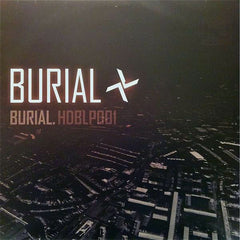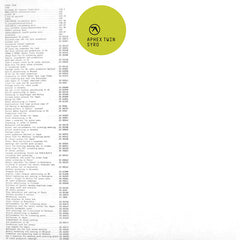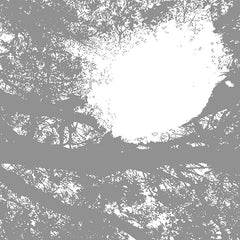
|
Comets On Fire - Field Recordings From The Sun LP (Ba Da Bing) Our Review: The first thing (the only thing?) you need to know about this Bay Area band is that "electric destruction fuzz guitar" is one of their instruments of choice. Wielded by Ethan Miller, and sometimes also by important Comets associate Ben Chasny of our fave acid-folk act Six Organs of Admittance, their "electric destruction fuzz guitar," with help from the band's fuzz bassist and sweaty drum maniac, puts Comets On Fire squarely into the psychedelic garage punk realm, shoulder to shoulder with the likes of 60's heavies Blue Cheer, and modern-day Japanese distortion fiends High Rise. Your friends from college will understand better if you compare Comets to Monster Magnet – they channel the same sort of MC5-ish ass-kickin' and Hawkwind-like space-outin'. And if Ethan (and Ben's) acid wah guitar leads weren't enough, the Comets take things to a whole 'nother plane of noise with the Echoplex electronic tweakery of Noel Harmonson. His overdriven oscillations multiply the freak-out quotient beyond numerical calculation. And live, his spastic jerking and clapping will occupy your attention visually, at least until the guitarist wrangles his axe into a feedback frenzy jammed up against his amp. But, there's another side to Comets On Fire, besides the distortion and the garagey riffs. Their loud freak-out elements are only part of an ecstatic musical continuum that also allows for the free jazz / ethnic massed bells and chant of track one, "Beneath The Ice Age." Two songs later, Six Organs guy Ben takes center stage, starting "The Unicorn" off with some improvised acoustic folk. Beautiful. Don't worry, though, 'cause soon enough the electric destruction fuzz guitar is back in action. Field Recordings From The Sun totally rocks, is totally awesome, and is the excellent follow-up (that we'd been eagerly anticipating) to their self-titled, self-released debut. |
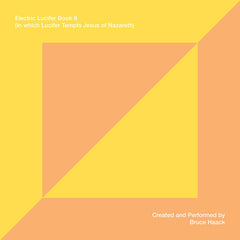
|
Bruce Haack - Electric Lucifer Book II LP (Telephone Explosion) Our Review: This is the previously unreleased 1979 sequel to Bruce Haack's 1969 Electric Lucifer, perhaps the most awesomely bizarre psychedelic pre-Kraftwerk electronica album ever to be released on a major label (Columbia) or elsewhere. The robotic voices and mechanical rhythms that made the first Electric Lucifer such a cult kitsch classic are still present on Book II, although it's perhaps more poppy and goofy and less disturbingly weird than its predecessor. Aside from that one (not-too-successful) major label release, Haack's career from the '60s through the early '80s focused on self-released electronic children's records, which while certainly amusing (and of interest for his innovative home-built synths), of course don't come close to the trippy electro-rock and serious religious themes of the Electric Lucifer concept. |
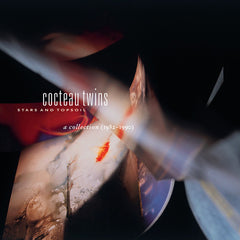
|
Cocteau Twins - Stars And Topsoil A Collection 2xLP (4AD) Our Review: Finally a good Cocteau Twins collection on vinyl! There has been plenty of anthologies and collections of this ethereal dream pop trio coming out since the band's 1996 break-up. We suspect that is partly to satisfy fans by collecting all the odds and ends the band recorded (they have 4 cds worth of singles and B sides alone), but perhaps also to get more fan influence to pressure the band to finally release their scrapped and abandoned last album. Here's hoping! Stars and Topsoil is a vinyl reissue of an 18 song compilation originally released on cd in 2000 of the band's picks from their essential 4AD catalog, from Garlands to Heaven Or Las Vegas, including rare ep and single tracks. Diehard fans who already own the records will no doubt have this stuff already, but for new fans or the newly curious, this is as good as a place to start as any. You can hear so many recent artists (Beach House, Gang Gang Dance, Ulrich Schnauss, M83, Sleep Over, Grouper, Ekin Fil, Puro Instinct, to name but a few) in the gauzy DNA strains of this seminal group. |
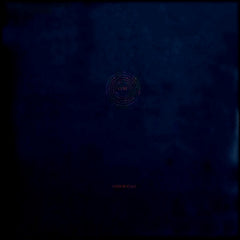
|
Coil - Backwards 2xLP (Cold Spring) Our Review: The Backwards sessions were long shelved due to legal disputes between various parties; but the recordings that are comprised on this posthumous release date all the way to 1992 with radical edits and revisions made during sessions at Trent Reznor's Nothing Studios in 1996. Backwards had long been promised as a release while Coil's founding members John Balance and Peter Christopherson were alive. While alternate versions of many tracks appeared on The Ape Of Naples and The New Backwards, this anthology revisits the original sessions as conceived and concluded in the late '90s. Throughout a storied career, Coil were always baroque proposition; and Backwards is very much a baroque album, with a kitchen sink of electronics and live instrumentation liberally saturated throughout the cryptically serpentine synth-pop sensibility that made Coil such a unique band. Skittering, static pulse sequences formed the basis to much of Backwards, alternating between darkly lysergic dance numbers and ballast-heavy marches of somber, twisted, and / or malignant thought. The titular track is certainly a standout with John Balance chanting amidst scurrying, hectic collages, countered by the swaggering hip-sway of the rhythm track - very much in keeping with what Coil had done on Love's Secret Domain. The immediate next track "Amber Rain", with its impassioned vocal hymn from Balance and an melancholy melody for synthetic piano, looks forward to what Coil would later do on Musick To Play In The Dark. Hindsight is 20-20, and of course, this album has been claimed to be - and should be seen - as the transition between those two landmark works by Coil. A very welcome entry in the already hallowed Coil canon. |
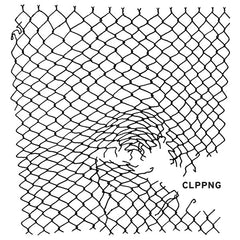
|
Clipping - Clppng 2xLP (Sub Pop) Our Review: The debut from LA noise-hop trio Clipping. (and yeah, the period is part of the name) finds roots in classic hip hop, but augmented with super minimal abstract noise, the sort of stuff you might hear on an RRR comp, think Bastard Noise or Sissy Spacek making a hip hop record and you'd be close. Even more interesting is that the two guys responsible for the music in Clipping. are Jonathan Snipes and William Hutson, might also be known for their stunning score to the Stanley Kubrick conspiracy documentary Room 237, the soundtrack which was released on Death Waltz. But this is no retro soundtrack. Clppng is twisted noisy weirdness, wild feedback drenched analog skree, squelch drenched gristle, hiss and hum and screech and howl and thrum and buzz, blasts of digital noise wound around low slung beats. From the onset, rapper Daveed Diggs spits rapid fire on devastating "Body And Blood" that rides a grinding industrial beat, with a creepy processed voice 'chorus.' Then "Work Work" surprises (as does much of the record), with its almost dreamy looped glitchy gamelan, that transforms into some low slung low rider booming bass throb. And while at first blush, some of the lyrics sound typically hip hop sexist, dig deeper, and there's way more going on, which is again balanced when Cocc Pistol Cree delivers her bad ass verse. And there are other guests too, King T, Gangsta Boo, Guce and more, but it's the core three who have their sound down. King T's guest verse on "Summertime" is a crusher, especially when the background sound swells into a cloud of alien laser blasts, deep bass thrum, and woozy sonic squiggles. Let's not forget the insanely infuriatingly brilliant "Get Up", where the music is just the sound of an alarm clock, maddening for sure, but then so satisfying when this modulates into a weirdly radio pop chorus. The magic of Clipping. is that it can be so obtuse and difficult, but still so groovy, so hooky, so funky, and so catchy. The vinyl edition comes in a super swank spot varnish printed gatefold, with an extra lp side, loaded with 100 locked grooves: noisy, distorted, blown out, abstract, dubby, clicky, funky, bloopy, bleepy and pretty much every variation in between. |
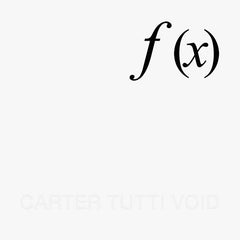
|
Carter Tutti Void - f(x) LP (Industrial) Our Review: That's Nik Void of Factory Floor once again joining the esteemed duo of Cosey Fanny Tutti and Chris Carter, proving that their first collaboration was not just a flippant one-off romp betwixt likeminded technicians; and hopefully, f(x) will be just one of many albums produced by this meeting of minds. As we experienced on the outstanding album of rebooted Chris & Cosey material, Carter Tutti has been exceptionally good as of late; and the insertion of Void into the mix changes that not one bit. If anything the pop quotient from the Carter Tutti productions has been distilled into faint melodies swimming amongst a chemical amalgam of hyper-processed / semi-aqueous sounds that are all suspended upon the girders of an almighty cybernetic whump generated with teethclenched tension. The rhythms begin and end with a chest-rattling pulse that is omnidirectionally nowhere and everywhere - the beat of an underground nightclub whose entrance cannot be found, the hollow-body vibrations from a multitude of car stereos straining at the urgency of those Gas albums from nearly 20 years ago, the chrome-plated precision of perfectly tuned machines purring at 126 bpm. Vocals and guitars from both Void and Cosey lock into place within these rhythms, albeit throughly processed, abstracted, haunted, and disembodied. The amount of details that pop into focus is startlingly dense for an album so overtly minimal, yet the trio effortlessly corral all of the component parts into one hell of a great electronic album. |
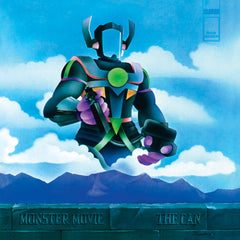
|
Can - Monster Movie LP (Mute/Spoon) Our Review: Monster Movie! This was the 1969 debut LP from The Can, that band of kraut-rockin', Stockhausen-studyin', JB's-lovin, beat-poetry-recitin' hippy freaks. Monster Movie features the unique vocals of Can's original singer, the African American singer Malcolm Mooney and establishes Can's signature style of relentless rhythmic psychedelia with songs such as the 20-minute "Yoo Doo Right" and the urgent groove of "Father Cannot Yell." Along with the Velvets and the Stooges, Can were one of the most advanced groups of the era, and certainly one of the best Krautrock bands. If you've yet to explore the world of Can, you could do a lot worse than starting here. |
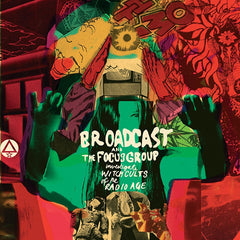
|
Broadcast and the Focus Group - Investigate Witch Cults Of The Radio Age LP (Warp) Our Review: Crystal balls, dark mirrors, Ouija boards, seances, creepy knocking, music boxes that play themselves, creaking doors, and distorted kaleidoscopes are just a few of the fascinating hauntological associations mined in the latest collaborative effort by long time shop faves, Broadcast, and new to us electronic outfit, The Focus Group, run by Ghost Box label head Julian House (who also designed all of Broadcast's record covers). Billed as a mini-album (23 tracks across 50 minutes), Broadcast and The Focus Group Investigate Witch Cults of The Radio Age is all at once a mesmerizing sound collage, a mind-warping concept album, a reimagined soundtrack to some chilling psychological cinema (we're thinking of films like Dead of Night, Secret Ceremony, The Ballad of Tam Lin, Persona, Angel, Angel Down We Go, or Simon, King of The Witches), as well as an homage to the obscure left-field psychedelic electronic music and sounds of the sixties and seventies that have influenced Broadcast over the years. Bands like White Noise, The Animated Egg, Basil Kirchin, United States of America, British Library Music and of course the BBC Radiophonic Workshop. So as you probably guessed from the description above, this is not a typical Broadcast release, but a experimental detour while we await for their next official full length. Fans of their full lengths may be less immediately satisfied by this, as it's not designed to be enjoyed as a pop record. It often requires either deep listening, or having it on while working on a solitary activity, such as painting or knitting, or better yet tarot card reading. While Trish Keenan's lush and dreamy singing is heard through out, there is only one typical Broadcast song, opener "The Be Colony," a woozy lullaby that hearkens back to the dreamy melodies from the HaHa Sound album, and even that is thrown in the delirious blender of The Focus Group, who took recordings made by Broadcast for this project and cut them up in a method to suggest automatic writing under a deep hypnosis. Disembodied voices, blowing wind, flashes of jazz drumming, eerie squeeches and electronic bloops, radio dials shifting, whining puppies, crows cawing, mysterious choirs and echo-y playground rhymes. Very ghostly, and sometimes beautifully creepy. It's the kind of strategy that may sound like it could get tedious after awhile, but the collage is so delicately and carefully constructed with just enough structured melodies that it wonderfully forms an intriguing narrative, of course aided by suggestive song titles like "Reception/ Group Therapy," "Ritual/ Looking In," "Libra, The Mirror's Minor Self..." and "Drug Party." We think that people who are less inclined towards Broadcast's pop albums and into spectral sounds, occult music compilations, electric voice phenomenon, experimental electronic music or music on the Type or Miasmah labels should definitely give this a listen. We haven't been so spellbound by a record in quite a while. Fantastic! |
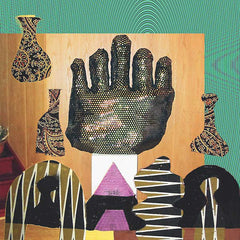
|
BJ Nilsen & Stilluppsteya / Anla Courtis - Golden Circle Afternoon LP (Editions Mego) Our Review: Ah, the plight of the supergroup touring the world with fits of drunkenness, wanton groupies, the drudgery of long travel days, and of course a couple of good gigs between. Such is the fictional landscape mapped out by the dada-punk sound artists BJ Nilsen, Sigtryggur Sigmarsson & Helgi Thorsson (aka Stilluppsteypa) and Anla Courtis. Nilsen & Stillupsteypa have been working together for many many years now, alternating releases between Editions Mego and The Helen Scarsdale Agency, proving to be a rare commodity in the realm of avant-electronics that a collaborative project can develop beyond the one-night stand of hedonistic improvisation followed by bouts of slumped file-sharing. No, their wintery psychedelic collages of existential madness, sheering drone, VHS horror sound design and Haflerian confusion have developed into one hell of an expressionist vocabulary. In bringing fellow paratactic musician Anla Coutis into the fold, the notion of these four embarking on some stupid-ass world tour akin to the Travelling Wilburys seemed apt. So, they ran with it in the same lysergic madness that Leif Elggren musters in his ludicrously brilliant art forms. The languid drones of the opening number "Aurora Australis" (named for the southern hemisphere polar-light phenomenon) suspends cryptic field recordings and nocturnal creaks upon corona-glow drones that ebb and flow with a psychological tension that Lynch & Splet mastered on the Eraserhead soundtrack, but here pocked with frightening gasps for air and violent jabs of noise. Side B's title "Fish Is God" seems like the punchline to a surrealist's knock knock joke; and if that may be an apt analogy, these four take that credo of absurdity rather seriously. Rolling out oceanic swells of rippling tone that rise up its tidal crescendo only to have its motion cut out with a dramatic tug to silence before an unsettling chunk of guttural vocalizations of an one-man orgy fitted to scabs of fragmented white noise. It's hard to really tell what Courtis may be up to in these procedures, as the album is very much a continuation of those amazing records that Nilsen & Stilluppsteypa have crafted over the years. Brilliant stuff. |
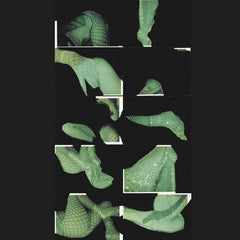
|
BJ Nilsen & Stilluppsteya - Goda Nott LP (Editions Mego) Our Review: The first three records from BJ Nilsen & Stilluppsteypa were a trilogy dedicated to alcohol and wintery drones, as semi-fictions about getting really drunk sometime in December and nearly passing out in a snowbank while gazing up at the northern lights. Goda Nott is something of an extension of these ideas, except maybe for the alcohol part. Sometime in the winter of 2011 / 2012, this trio found themselves snowed in at Stilluppsteypa's Icelandic studio with no food or water; and no way of getting out until the snow began to melt away. While they did sleep as much as they could to pass the time, they also busied themselves with recording the sounds of the snow, ice and wind, attempting to monitor what - if any - activity may exist beyond their frozen enclave. The possibility of any existence beyond their own became uncertain, where any rustling of the snow could be a footstep or a resonant tone could be a snowplow. Through their indeterminate amount of time in that studio, they smeared these field recordings into rumbling drones and static tones that mirrored the onset of their collective madness, made audible in the crazy sounding whistling that one of them fastens to the blustery isolationism of the first side of Goda Nott. The second side is even more desolate than the first, rivaling Kevin Drumm's Imperial Distortion for the most empty, most gasping, most claustrophobic slab of audio bleakness we've ever heard. This is a radical turn away from the melancholy kosmiche electronica of their previous two albums Space Finale and Big Shadow Montana; but they are also rendering something wholly new to the bad-ass dronescaping they mastered early on. So fucking good. |

|
Antony And The Johnsons - The Crying Light LP (Secretly Canadian) Our Review: I Am A Bird Now is a really touch act to follow, but The Crying Light glows in its own unique beauty. Filled with lush arrangements and gorgeous orchestration, and of course Antony's one of a kind magical voice that is absolutely heavenly. Exploring similarly emotional and stunning stratospheres as folks like Rene Joly, Nina Simone, Bryan Ferry and Arthur Russell, while employing a remarkable group of musicians (Nico Muhly, Greg Cohen, Doug Wieselman, etc.), but ultimately it's Antony's incredible songwriting and delivery that elevate his work to that highest level of musical achievement. While not a dramatic departure from the haunting and emotionally charged sounds of I Am A Bird Now, this record still finds its own voice. Focusing on nature, and our relationship to nature in the smallest and most grandiose ways, Antony ponders our lives, births and deaths, as these songs make you stop in your tracks and soak up the wind and air and spirits that surround us. This is the kind of record that keeps revealing itself on repeated listens. Of course, highly recommended! |
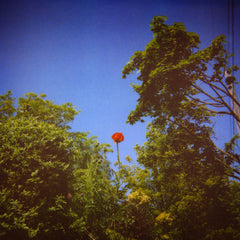
|
Benoit Pioulard - Sonnet LP (Kranky) Our Review: Benoit Pioulard's fifth album shifts away from his languid dream-pop songs of bedroom folk melancholia sung with a maudlin, reverb-saturated baritone we'd often heard from him before, in favor of thoroughly abstracted numbers. He builds this lush shoegazing wash from field recordings and his responses to them through guitar and tape manipulation, with nothing digital getting in the way of all of this tactile, gossamer haze. Sonnet is an entirely instrumental album, which is certainly not out of the ordinary for the roster of Kranky Records, the home for A Winged Victory For The Sullen and Tim Hecker, two heavyweights of blearily atmospheric music; but we have to say that the Pioulard (instrumental) voice is especially a thing of beauty. The sibilance of air conditioning vents, summer time lawn sprinklers, washing machines and the mid-day rasp of a swarm of locusts can become indistinguishable from amplified tape hiss. That's where Pioulard (who sounds French but is actually a Pacific Northwesterner named Thomas Meluch) begins to shape the work of Sonnet. Guitars, loops, and some twinkling synths come into the mix all of which are firmly sympathetic and complementary to the bittersweet coloring from his tapestries of sound. These droning nocturnes reflect the shimmer and feel of a Cocteau Twins instrumental or the ambient interludes found on Boards Of Canada or the even more soaring numbers from Troum. Highly recommended, this gets asked about and purchased by customers nearly every time we play it in the store! |
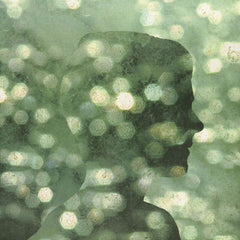
|
Benoit Pioulard - Precis + Temper 2xLP (Kranky) Our Review: Benoit Pioulard is but a pseudonym for a young avant-folk tunesmith named Thomas Meluch, who now lives in Portland, Oregon yet grew up in Michigan. His gauzy dream-pop has much in common with those sounds that spilled out of Michigan with Windy & Carl, Fuxa, Auburn Lull and even Veronica Lake in the mid '90s. There is a decided craftsmanship that further distances his work from the shambolic affairs that dominate his current hometown, yet this album is not without its narcotic impressionism through his gauzy smears of ambience across his wistfully strummed acoustic guitar numbers. Temper is his second album released through Kranky, and that's a damn proper place for the man. Well, yes, Windy & Carl do release records through Kranky; but his work also fits along very well next to Stars Of The Lid and Labradford. The album's opening cut "Ragged Tint" is atypically urgent in its doubletimed elliptical fingerpicking which speeds past Pioulard's vocals which are sort of like mumbling Stephin Merritt if we could make that sound like a very good thing. A heartbreakingly sad glockenspiel melody tumbles into the chorus of the song, tempered with reverb and delay to match the hue of his dreamy drone-pop. The rest of the album is set at a languid pace, more in keeping with the first Iron & Wine record, complete with lo-fi bedroom recordings and sad little ditties strummed across his acoustic guitar girded with softened Boards of Canada rhythms. Each of his songs are effortless, beautiful, melancholic and totally worth getting stuck in your head. He brackets each of his songs with softly treated field recordings made on a well-worn walkman that has never had its heads cleaned. So the rainstorms and birdsongs are cast in a mottled gray fog of thick tape hiss, which turns bleary and sad through Pioulard's treatments. As one customer who bought this record from us said, "it's too pretty not to buy!" This also comes with his first album on Kranky, Precis. |
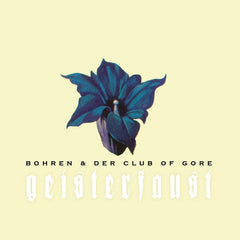
|
Bohren & Der Club Of Gore - Geisterfaust 2xLP (PIAS) Our Review: Not metal -- not remotely. So why did they get written up in Terrorizer magazine? Well, this German four-piece isn't exactly a jazz band either, even though they utilize such instruments as Fender Rhodes electric piano, vibraphone, double bass, and saxophone. They're actually really heavy though it's always hard to explain how something this quiet and this pretty can be "heavy". But you'll feel it when you hear it. Their special brand of Teutonic, minimalist, noir-jazz influenced "heaviness" is not to be denied. A Bohren album cannot be properly absorbed in little snippets. The time frame within which their compositions work is not conducive to quick scans or distracting environments -- even the shortest of the five tracks here isn't much less than eight minutes in length, and the opening track "Zeigefinger" is a 20+ minute experience. At Bohren's usual glacial pace, which utterly starts to alter one's perception of time. The long songs are endless. Eternity telescoped. So spare and melodious. The vast space of Bohren's music makes the listener concentrate and gives each sound extra weight and meaning. The Bohren aesthetic certainly holds that less is more. Even though there's guests -- a tuba player and a choir, even -- augmenting the basic Bohren quartet on several of these tracks, you're never overwhelmed with sound, but with silence. Geisterfaust flows exquisitely. Calm. Cool. Bliss. Stupor. So gorgeous, so heavy. Basically it's like some utterly slow crushing doom band. The Melvins at their most monolithic, or Khanate or Caspar Brotzmann Massaker or Corrupted with their instrumentation transposed into the jazz realm. The snare only brushed. The distorted electric guitar replaced with the tinkle of a Rhodes piano. Notes not riffs. Played like a dirge, with hints of drone, sombre and sad, but beautiful. |
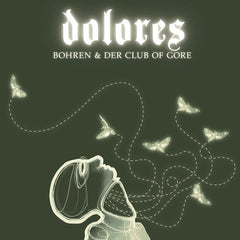
|
Bohren & Der Club Of Gore - Dolores 2xLP (PIAS) Our Review: Imagine a blackened, funereal doom band like Skepticism or Nortt morphed into the jazz idiom, playing their slow, sad music in a smoky Berlin jazz club. The sound is jazz (electric piano, organ, vibes, sax, double bass, trap kit), but the feeling is doom. That's the usual shorthand for describing the unique music made by Germany's Bohren & Der Club Of Gore. Here is their eagerly anticipated 5th album, Dolores. It's just as ponderously "heavy" as a "jazz" band can be. No, not loud, not harsh, not noisy. The opposite of all that. Rather, whisper-quiet, glacially slow, and spacious with sparse snare hits keeping time like a wound-down clock ticking off the eternity between 2 minutes to midnight and the witching hour itself. Doomsday so slowly arrives on a velvety bed of somnolent deep bass notes and the cool slinky tones of vintage Fender Rhodes. Cymbals shiver in a dark haze of ambient drones near to silence. Several of the songs are infused with the warmth of tenor or baritone sax breathes gorgeous expiring breaths. It's all so sad and woeful and achingly beautiful, Bohren nodding off, their fragile melodies trickling like tears, and by the end you may find you have shed a few too. |
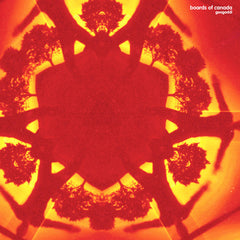
|
Boards Of Canada - Geogaddi 2xLP (Warp) Our Review: For those of you who love the Boards of Canada mellow electronica sound and have committed their debut full length Music Has the Right to Children to memory, here are 66 minutes more of the same delicious recipe: emotional minor-key organ / piano / synth melodies, looped samples of record static imparting an aged, organic patina to the entire album, disembodied voices murmuring, electronic glitches that aren't there for glitch's sake but to bring drama to the narrative of the album, and lush deep s-l-o-w breakbeat rhythms that add a shimmering tension to the music. The Scottish duo's music is still interesting, thankfully not boringly repetitive, and artistically successful. A lovely record. |
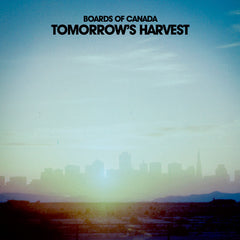
|
Boards Of Canada - Tomorrow's Harvest 2xLP (Warp) Our Review: Boards Of Canada have never deviated much from what they're best at: well composed and structured melodies that have a worn, warm and warbled sense of nostalgia. Aged library sounds, abstract organic design and educational nature film scores were often the heart of the bands reference points. So it's 2013 and we finally have a brand new record and it's definitely their most mature and complex record to date. While it has certain touchstones that make it sound distinctly like a Boards Of Canada record, the feel overall is much darker, tense and moodier, reading like a score to some environmental science fiction film like Idaho Transfer or Phase IV (or more recently, Beyond The Black Rainbow!). Even the album title and the cover shot (of San Francisco, taken from the Alameda Naval Shipyards) gives off a Soylent Green vibe. The nostalgic quality that permeates the band's sound has a more toxic feel this time around too, as if hearkening back to a place now poisoned, a kind of daylight horror dread. The opening track, "Gemini" starts out with a crackly filmstrip fanfare like from some old seventies educational film, and that sort of faded, gristly, sci-fi vibe pervades throughout the first track, a dark, blurred, fuzzy field of pulsing synths and ominous atmospheres, it's immediately evident, that the new Boards Of Canada is a much darker beast than the group who brought us the pastoral, autumnal Music Has The Right To Children. Boards Of Canada fuses the old loping, meandering beat driven dreaminess to something a shade darker. Some tracks locked into tranced out smoldering grooves, draped in chiming softly distorted melodies, others, brooding menacingly, some peppered with creepy processed voices, only adding to the seventies creepy sci-fi/horror flick vibe. Others blossom into time-lapse slow motion sprawling expanses of experimental rhythmic textures, shifting dreamily, tonal colors bleeding into each other, woozily prismatic, like the music from some old crumbling, planetarium show. While the old Boards Of Canada sound surfaces throughout, Tomorrow's Harvest, definitely exists in a much bleaker soundworld. These sounds the score to a future world scorched and barren, a world of faded memories of what once was, and what could have been, had it not all gone terribly wrong. |
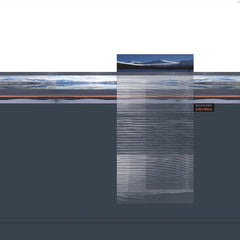
|
Biosphere - Substrata 2xLP (Biophon) Our Review: Substrata is often heralded as the grand statement of Biosphere, and gets lumped alongside Boards Of Canada's Music Has The Right To Children and Aphex Twin's Selected Ambient Works Vol. II as one of the best electronica records from the '90s. There's little to argue with such claims, even with a half-dozen or so of stellar records that followed this album. Originally released back in 1997 on All Saints Records and repackaged as a double-disc with Biosphere's soundtrack to the Russian silent film Man With A Movie Camera in 2001, now the album gets released on vinyl for the very first time. Like all great ambient records, Substrata works because of its subtlety, balancing soft-focus melodies that never assert themselves too much, but never fade so far into the background to become irrelevant. Given that his previous records smoothed out contemporary techno for the chill-out crowd, Substrata is a logical extension of Biosphere's sound for billowing synth-pad sequences and time-suspending ambience that never has to give over to the release of a big 909 backbeat. "Chukhung" cycles through muted arpeggios with layered chiming strings that gently rasps against the pastoral ambience to give the piece a crescendo of drama and softened tension. "The Things I Tell You" refines the tremolo / delay ambience that Pete Namlook was churning out into a quintessential Biosphere number rippling in time with an arctic wind pushing flecks of snow across a landscape lit by the midnight sun. Vocal snippets swimming in echo, aqueous passages, reverberant acoustic guitar plucks, and looped field recordings dot the album's resonant ambient hum, providing small signposts more to mark the passage of time than to assign any particular allusion. Biosphere rounds out the vinyl edition with a 14 minute bonus track entitled "Laika", although it's unclear as to when this track was produced. This album offers up beautiful music for lucid dreams. |
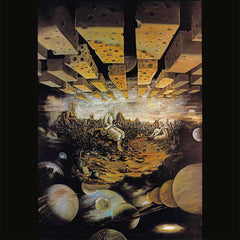
|
Algarnas Tradgard - Framtiden Ar Ett Svavande Skepp, Forankrat I Forntiden 2xLP (Subliminal Sounds) Our Review: This is one of those essential reissues that remind us that everything cool was already done about forty years ago. Yep, these Swedish hippies sure knew what they were doing. Timeless psychedelia from 1972. Algarnas Tradgard (Garden of the Elks, in English) were droning away darkly on violins and cellos before Godspeed! You Black Emperor ever matriculated into the Suzuki School. Here's a classic from back in the day that ought to enter (and alter) your consciousness. To utilize a period comparison, imagine the kosmiche krautrock vibes of Amon Duul mixed with Nordic forest-darkness, as this group of solemn longhaired freaks space-out with their guitars, drums, strings, sitars, tabla, Moog synth, jew's harp and various other exotic instrumentation. There's some folky female vocals a la Fairport Convention and the occaional group chant, but Framtiden is mostly instrumental and entirely magical. This album reveals Algarnas Tradgard as creators of dark stoned driftdrone every bit as cinematic as the best GYBE and even more authentically psychedelic than many of the current practioners. It's lovely, blissful, transportational stuff indeed. A quick guide to the crucial Swedish psych essentials definitely includes this, along with Parson Sound, Bo Hansson's Lord Of The Rings opus and the International Harvester album. This deluxe double lp taken from original master tapes with the second lp featuring previously unreleased bonus tracks. Packaged with liner notes from the band and previously unseen vintage photos. |
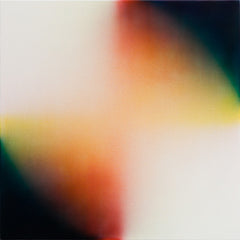
|
Bing & Ruth - No Home Of The Mind LP (4AD) Our Review: On their debut album for 4AD, Bing And Ruth build on the teeming, crepuscular minimalism of their last outing, honing a sound both dense and weightless, hanging as if suspended in an elegant, endless freefall. A seven-piece group for the 2014 breakout Tomorrow Was The Golden Age, here David Moore's ensemble top out at five: two basses, clarinet, piano, and tape delay operation. Prodigiously rehearsed and then recorded in just two days, No Home Of The Mind's ten tracks unfurl as one seamless suite, their titles – "The How Of It Sped," "Form Takes," "To All It" – equal parts Aram Saroyan and Wire. The strongly filmic element of Bing and Ruth's music here makes itself strongly felt, conjuring Terence Malick's sun-dappled late afternoons, Amanda Arnold's poignant quotidian melodramas, and Guy Maddin's wordless explorations of memory. No Home Of The Mind is Bing And Ruth's best album yet, its shimmering, languid expanses providing something like the very refuge its title announces missing. |
- Previous
- Page 7 of 7

